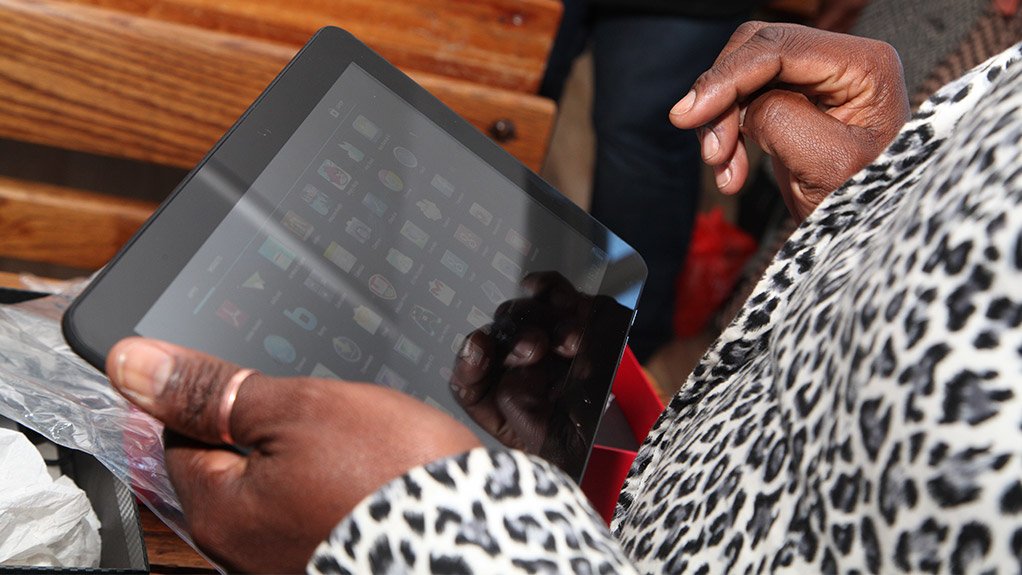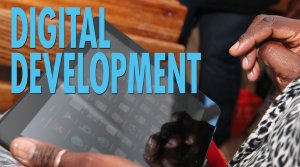R9bn ICT research roadmap moves into implementation stage, but funding remains a challenge
Following the April approval by Cabinet of the information and communi- cation technology (ICT) research, development and innovation (RDI) roadmap, the Department of Science and Technology (DST) and the Council for Scientific and Industrial Research’s (CSIR’s) ICT arm, the Meraka Institute, are moving to roll out the plan.
The roadmap, a long-term investment and implementation framework that seeks to build on the 2007 ICT strategy, will move to guide, plan, coordinate and manage South Africa’s portfolio investment in ICT RDI over the coming decade.
The document is the culmination of intense consultations with public- and private-sector stakeholders and experts and is said to be in line with the National Development Plan, as well as – arguably, more precisely – with the Presidential Infrastructure Coordinating Commission’s Strategic Integrated Project 15 – a plan that aims to expand access to communication technology and provide a platform to boost the competitiveness of an economy that has lost its status as continental leader in Internet and broadband connectivity, while supporting socioeconomic development.
“The ICT RDI roadmap builds on the ICT RDI strategy that was adopted in 2007. The 2007 strategy had, as its objectives, to create critical mass ICT research and development (R&D) capability, establish a robust innovation chain and promote the development of advanced human capital in ICT,” says DST chief director of sector innovation and change Isaac Maredi.
Plan’s Priorities
The roadmap identifies six potential clusters – namely broadband infrastructure and services; ICT for development; sustainability and the environment; industry applications; grand science; and the services economy – that can be broken down into 27 market opportunities aligned with South Africa’s national priorities.
The broadband infrastructure and services cluster comprises markets such as future wireless technologies and broadband service infrastructure, while ICT for development will focus on markets such as e-inclusion, development and agriculture.
The sustainability and environment cluster encompasses the green ICT, global change and geospatial applications markets and the grand science cluster covers the ICT components of markets such as astronomy and biomedical science.
The service economy cluster, meanwhile, not surprisingly, comprises the most potential markets, including m-health; e-services; education; payment solutions; business model innovation; outsourced South African capability; systems integration content and service localisation; trust and security; and mobile enablement.
The existing capabilities for each of these market opportunities are understood, as are the size and nature of the opportunity, Meraka executive director Laurens Cloete explains.
In May, Nokia Middle East and Africa VP Jussi Hinkkanen commented: “In an initiative like the ICT RDI roadmap, building a long-term investment plan is fundamentally important as it helps you and companies know what the weaknesses and opportunities are and how to tackle where we want to go.”
The roadmap indicates that the nature of the return on investment lies in the impact it would deliver for the economy and for society and in its creation of a national ‘digital advantage’.
Catalytic Tool
ICT is widely recognised as a “potent tool” for socioeconomic upliftment, with research over the last ten years showing that the development of ICT, whether mobile or traditional technologies, has had a massive impact on national economic and, in turn, social, development and was becoming a catalytic tool for national development.
The DST’s existing investment in ICT R&D, as well as the CSIR’s Parliamentary grant investment in ICT R&D, has been realigned to the roadmap, with the DST tabling business and funding plans for implementation to this end.
The Meraka Institute is currently in discussions with the National Treasury for additional funding, but the intention is to also attract private resources. When funding is secured, it will allow for full implementation of the ICT RDI roadmap, Cloete notes.
The R9-billion budget for the roadmap was determined by examining each cluster and market opportunity and assessing what would be needed to build the required R&D capability, while stimulating R&D that would lead to technology transfer, new products and services.
Maredi says the budget determination has also been based on several other factors, including the appropriate level of R&D spend on ICT.
“South Africa is at the forefront of measuring our R&D spend using the internationally recognised Organisation for Economic Cooperation and Development Frascati methodology. From these surveys, we know that countries like Brazil and Australia spend approximately four times what South Africa does on ICT R&D. Countries that are leaders in ICT exports, such as South Korea and Taiwan, spend up to ten times as much as South Africa,” he says.
Multiplier Effect
While the roadmap estimates a multibillion- rand investment over a decade, the plan ambitiously outlines an expected contri- bution of more than R120-billion to the economy each year, the creation of one large business, 37 medium firms, 190 small business and 2 200 microenterprises, as well as the creation of 4 225 high-technology jobs and 19 475 other jobs.
Cloete, for instance, has noted that, when Internet penetration rises by 10% in emerging economies, gross domestic product (GDP) increases 1% to 2%. He also points out that the GDP growth rate of developing countries has been shown to be boosted by an average 0.59% a year for every ten mobile telephones added for every 100 inhabitants.
Further, the example of the US economy showed that, every dollar invested in broadband provided a tenfold return, and that faster broadband deployment in Europe, for instance, could create one-million jobs and growth of €850-billion by 2015.
“ICT has been the main driver of Kenya’s economic growth over the last decade. Since 2000, Kenya’s economy grew at an average of 3.7%. Without ICT, growth would have been a lacklustre 2.8%,” he notes.
The Landscape
South Africa’s RDI landscape currently com- prises several universities with active research groups in ICT; a small number of multi- national companies with a significant and expanding research presence in the industry; a growing list of incubators and entrepre- neurial development programmes contributing to small-scale innovation; and a strong promotion of RDI by government through various large-scale initiatives and institutions, including Meraka and the Media Information and Communication Technologies Sector and Training Authority.
But there are also areas of concern, notably South Africa’s current pipeline of human capital and talent, the scarcity of focused funding efforts and the lack of coordination and cooperation among the institutions involved in ICT RDI.
“We looked at global trends, where technology is going – we don’t want to invest in something that is in the past, that missed the opportunity. We [also] looked at the country’s capability, what strengths we have [at] industry, government and university [levels],” says Cloete.
The roadmap indicated that South Africa spends close to 10% of GDP on ICT goods and services, most of which are imported, while the ‘R&D intensity’ of South Africa has stabilised at around 0.92% of GDP over the past few years, below the global norm of 2%.
The baseline research underpinning the plan showed that South Africa is a net importer of ICT goods and services, accounting for about 8.8% of total imports, compared with 1.6% of total exports. Comparing the country’s counterparts in the Brazil, Russia, India, China and South Africa (Brics) economic bloc, barring China, South Africa spends close to double what these Brics countries spend on ICT as a percentage of GDP, which means that a significant portion of South Africa’s wealth is spent on foreign ICT goods and services.
Further, while government, universities and science councils have an interest in ICT RDI, funding and current spending on R&D in the sector are limited, compared with other fields.
The Plan
The roadmap will build on current initiatives and provide a set of action plans to increase R&D intensity in the ICT sector and build ICT RDI capabilities focused primarily on local needs, with export potential in the longer term, by catalysing government and industry investment.
“If we are to deliver the intended impact, we must strengthen our national ICT RDI ecosystem through well-coordinated and well-managed collaboration between research institutions, academic institutions, industry and government line departments,” the report states.
Deemed a critical success factor for ICT RDI is the effective collaborative partnerships between science councils, higher education institutions and the private sector.
Meraka established the ICT Multinational Corporation project management office – operated within the framework of the road-map by a DST director-general Dr Phil Mjwara-chaired committee – to further strengthen the DST’s strategic partnerships with multinational ICT companies such as SAP, Nokia and Microsoft, besides others.
Multinationals generally examine the size of the local market, the availability of the right type of skills, supportive instruments and the intellectual property regime, besides others, when investing in R&D capacity.
“[Clear priority areas for R&D investment] give multinationals confidence that South Africa is serious about these areas and that requisite R&D capacity is being built in these areas. Even at this early stage, the partnerships with multinationals have led to investment of in excess of R100-million by them in local R&D projects and capability,” Cloete adds.
The roadmap also indicates that the vision of attaining ‘digital advantage’ will be achieved by providing critical mass for research in prioritised areas and mitigating the areas of concern surrounding the current pipeline of human capital and talent in the ICT RDI sector.
Cloete points out that South Africa has the capability to compete internationally but lags in terms of capacity, as the nation produced too few scientists beyond the first degree, citing South Africa’s output of 30 PhD graduates for every 1 000 students achieving some sort of ICT degree, compared with Ireland, which hosts a tenth of South Africa’s graduation population but produces about 200 PhD graduates a year.
The roadmap’s baseline research shows that graduations in ICT-related fields have decreased, with a scarcity of instruction and supervision staff in ICT fields. A high dropout rate for bachelor’s degrees is also recorded, which creates a domino effect, resulting in very few graduates with master’s and doctoral degrees in ICT.
Key Projects
The ICT RDI Strategy of 2007 has already started yielding significant tangible achievements through a systematic approach to understanding the problem and developing a solution treating the core issue and not just covering the symptoms, Meraka reports.
It is on this basis that the institute and its partners are moving forward in adopting the 2013 roadmap’s priorities.
“Various current Meraka-led initiatives are aligned to the roadmap and represent the organisation’s response to the roadmap. Broadband, for instance, is both a cluster in the roadmap and one of Meraka’s six growth and impact initiatives. Similarly, the CSIR’s Smart World initiative supports the R&D of technology and applications in the smart infrastructure and green and ICT market opportunities,” Cloete tells Engineering News.
Further initiatives include the wireless mesh technology demonstrator project, under the Broadband4All initiative, which supports the cost-effective delivery of broadband connectivity to more than 200 rural schools in Mpumalanga and Limpopo.
Meraka aims to develop and apply tech-nology-based interventions for improved education in rural areas, as many of South Africa’s estimated 26 500 schools – 17 000 of which are in rural and remote areas – are without connectivity and access to the Internet, hampering access to education.
The institute notes its Broadband4All initiative works to bridge the digital divide in a country that only has 17% Internet penetration and bring the social and eco- nomic benefits offered by affordable and sustainable broadband connectivity to rural communities.
The low-cost building and sharing of the connectivity platform used to expand coverage within local communities negate the need for expensive radio equipment and high radio towers, and adequately skilled and trained local entrepreneurs, also known as Village Operators, will be responsible for operating, promoting and expanding the Broadband4All offering in their respective communities.
Hundreds of research and educational sites have also been connected to the South African National Research Network (Sanren) high-speed network, which is currently used by over 700 000 people a day, says Meraka manager for strategic initiatives and contract R&D Kobus Roux.
The investment in Sanren has reduced Internet costs for participating institutions by a factor of more than ten. The DST earlier this year committed about R600-million over the next five years to more than double the international bandwidth of Sanren.
The CSIR is currently evaluating tenders received for the provision of services and networks for Sanren Phase 2.3, which involves the further extension of the network backbone and the establishment of metropolitan optic-fibre networks in some smaller metros and municipalities.
The project was divided into 12 subprojects, which were to have been awarded separately by the end of August. The extension will kick off this month and be completed by March 2014.
Meanwhile, initial results from Meraka’s rural education pilot programme indicate the potential to scale up sustainability following the successful distribution of multimedia tablets to teachers and students of the Arthur Mfebe Senior Secondary School, in Comfivaba, in the Eastern Cape, in August last year, says Meraka ICT for education and mobile learning manager Merryl Ford.
The schools were connected to the Internet through satellite and wireless mesh tech- nologies.
To date, Meraka, in conjunction with the Department of Basic Education and the DST, besides others, has delivered tablets to 26 Nciba Circuit schools in the Comfivaba school district, benefiting 6 500 learners, 350 teachers and 16 district officials.
The pilot has been expanded to include a further 11 schools, with the first round of training of teachers in the use of multimedia tablets, and ensuring connectivity, under way. The initiative will supply tablets to a further 14 schools in 2014.
Further, ten schools in Cape Town have been connected to the Internet following the start of Meraka’s first trial studying the effects of connecting underserviced regions to the Internet using television white spaces – unused bands of frequencies reserved for television broadcasting.
Over the next two years, the group will establish an ICT education advisory board and expand initiatives such as the ICT4Red pilot project, its Mxit-based Dr Math tutor programme, which is a peer-based learning programme called Mathlete, and the ‘digital doorway’ – a free-standing multimedia computer terminal with a keyboard and touchpad embedded in a robust kiosk, accessible to the public 24 hours a day.
Geospatial research investment has led to the development of the satellite-based Advanced Fire Information System, or Afis, which is currently used by 40 fire protection associations and by a number of other institutions, including State-owned power utility Eskom.
The real-time wildfire detection, monitoring and alerting system, uses satellite sensors and imaging to alert infrastructure owners, land managers, disaster management and fire protection personnel to fires in their areas.
Further, the satellite earth observation initiative helps South Africa to understand the state of natural resources, to study climate change and the environment, manage natural disasters and provide warning of regional droughts, floods and other potential disasters.
The use of earth observation products and services could increase innovation and enable sustainable use of natural resources and the environment.
Comments
Press Office
Announcements
What's On
Subscribe to improve your user experience...
Option 1 (equivalent of R125 a month):
Receive a weekly copy of Creamer Media's Engineering News & Mining Weekly magazine
(print copy for those in South Africa and e-magazine for those outside of South Africa)
Receive daily email newsletters
Access to full search results
Access archive of magazine back copies
Access to Projects in Progress
Access to ONE Research Report of your choice in PDF format
Option 2 (equivalent of R375 a month):
All benefits from Option 1
PLUS
Access to Creamer Media's Research Channel Africa for ALL Research Reports, in PDF format, on various industrial and mining sectors
including Electricity; Water; Energy Transition; Hydrogen; Roads, Rail and Ports; Coal; Gold; Platinum; Battery Metals; etc.
Already a subscriber?
Forgotten your password?
Receive weekly copy of Creamer Media's Engineering News & Mining Weekly magazine (print copy for those in South Africa and e-magazine for those outside of South Africa)
➕
Recieve daily email newsletters
➕
Access to full search results
➕
Access archive of magazine back copies
➕
Access to Projects in Progress
➕
Access to ONE Research Report of your choice in PDF format
RESEARCH CHANNEL AFRICA
R4500 (equivalent of R375 a month)
SUBSCRIBEAll benefits from Option 1
➕
Access to Creamer Media's Research Channel Africa for ALL Research Reports on various industrial and mining sectors, in PDF format, including on:
Electricity
➕
Water
➕
Energy Transition
➕
Hydrogen
➕
Roads, Rail and Ports
➕
Coal
➕
Gold
➕
Platinum
➕
Battery Metals
➕
etc.
Receive all benefits from Option 1 or Option 2 delivered to numerous people at your company
➕
Multiple User names and Passwords for simultaneous log-ins
➕
Intranet integration access to all in your organisation





























